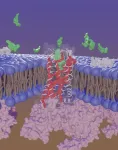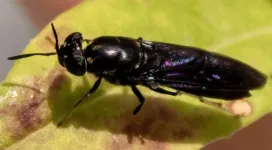(Press-News.org) COLUMBUS, Ohio – Gene therapy might offer a one-time, sustained treatment for patients with serious alcohol addiction, also called alcohol use disorder, according to a new study led by a researcher at The Ohio State University Wexner Medical Center and College of Medicine.
The animal study, published in the journal Nature Medicine, also involved researchers at the Oregon Health and Science University, the Oregon National Primate Research Center and the University of California San Francisco.
The study used an accepted primate model to show that sustained release of glial-derived neurotrophic factor (hGDNF) in a region of the brain called the ventral tegmental area (VTA) may prevent a return to excessive alcohol use after a period of abstinence. Furthermore, it may do so without disrupting other motivated behaviors.
“This gene-therapy approach targets changes in dopamine function in the brain’s mesolimbic reward pathway that are caused by chronic alcohol use,” says co-principal investigator and co-corresponding author Krystof Bankiewicz, MD, PhD, professor of Neurological Surgery and director of the Brain Health and Performance Center at Ohio State. “Our findings suggest that this treatment can prevent relapse without requiring long-term treatment adherence by patients.”
People with alcohol use disorder (AUD) commonly experience repeated cycles of abstinence followed by relapse, even when using one of the few FDA-approved drug therapies, Bankiewicz notes.
Excessive alcohol use alters certain nerve tracts in the brain that involve the release of the neurotransmitter dopamine. These neurons make up the mesolimbic reward pathway, which plays a major role in alcohol and drug addiction.
These alterations become more pronounced as AUD develops. They include reduced levels of dopamine release, reduced sensitivity of dopamine receptors and increased dopamine uptake. These changes lead to below-normal levels of dopamine in the pathway.
Scientists think this “hypodopaminergic” state can compel excessive alcohol users to resume drinking after periods of abstinence.
“At this time, there are no therapies that target circuits in the brain that are altered by sustained, heavy alcohol use,” says co-principal investigator and co-corresponding author Kathleen Grant, PhD, chief and professor of Behavioral Neuroscience at the Oregon National Primate Research Center.
How the study was done
This study used an accepted rhesus macaque model of AUD to examine the practicality and effectiveness of delivering a viral vector into the brain to induce continuous expression of GDNF, diminish alcohol use and prevent post-abstinence resumption of drinking.
Eight male rhesus macaques were involved; the vector was an adenoassociated virus vector that carried a gene for human glial-derived neurotrophic factor (AAV2-hGDNF).
All eight animals were first habituated to the consumption of 4% alcohol. Then four animals were infused with the hGDNF vector directly into the VTA, located in the floor of the midbrain. Neurons in the VTA connect with the mesolimbic reward pathway. The remaining four animals served as controls. They were infused with sterile saline using the same surgical procedure.
Key findings included:
The infusion of AAV2-hGDNF significantly blunted the intake of alcohol across multiple 4-week abstinence and 4-week alcohol-reintroduction cycles;
Blood ethanol levels were undetectable in GDNF-treated subjects and remained undetectable for most weeks through the study’s end;
Control subjects showed consistently elevated monthly and weekly alcohol intake and blood ethanol levels across cycles, as a group and individually.
“Overall, our findings indicate that GDNF gene therapy could diminish reintroduction-associated alcohol intake in our primate model,” Bankiewicz says. “We believe this approach shows merit for further study as a promising therapy for AUD and possibly other substance-abuse disorders.”
Alcohol Use Disorder
An estimated 28.6 million American adults ages 18 and older (11.3% in this age group) and 894,000 adolescents ages 12 to 17 (3.4% of this age group) had AUD in 2021, according to the National Survey on Drug Use and Health.
An estimated 12% of all alcohol consumers meet the criteria for AUD as defined by the Diagnostic and Statistical Manual for Mental Disorders 5th edition.
140,000 deaths per year in the United States are attributed to alcohol use disorder, according to the Centers for Disease Control and Prevention.
This study was supported by grants from the National Institutes of Health (AA024757, AA013510, AA014091, AA010760, AA019431, OD011092, AA026117).
Other researchers involved in this study were Victor S. Van Laar, Jerusha Naidoo, Piotr Hadaczek, Lluis Samaranch, The Ohio State University; Matthew M. Ford, Lauren E. Vanderhooft, Jodi L. McBride, Oregon National Primate Research Center, Oregon Health & Science University; Brianna George, Katherine M. Holleran, Emily G. Peck, Monica H. Dawes, Sara R. Jones, Wake Forest School of Medicine; Kousaku Ohno, John Bringas, John R. Forsayeth, University of California San Francisco.
# # #
Written by Darrell Ward, wardwriter.81@gmail.com
END
USC Schaeffer Center and University of Minnesota researchers found that study participants without a college degree had even larger employment gains from lifestyle changes recommended by specialists.
Study takeaways:
Published in JAMA Internal Medicine, the study reveals that intensive lifestyle intervention to prevent the progression and complications of type 2 diabetes is associated with higher employment.
Lifestyle intervention was associated with a 4% increase in employment overall, and a 7% increase among participants with less than a college degree.
Findings suggest labor market productivity should be considered when evaluating the cost effectiveness ...
In more than 30 cities around the world, millions of people obtain their drinking water from storage tanks – because tap water is often available for only a few hours at any one time. When the public water supply is insufficient, households and businesses mostly resort to private providers. Trucks bring drinking water – often tapped from groundwater wells – from the countryside to the cities and sell it there. This is partly licensed by the state but largely takes place illegally. “In Jordan, these water deliveries by tanker truck make up for the deficit of the public water supply network”, ...
FINDINGS
Scientists at City of Hope, one of the largest cancer research and treatment organizations in the United States and a leading research center for diabetes and other life-threatening illnesses, have uncovered new molecular targets on a cell receptor that play a major role in cardiovascular regulation. The findings could lead to improved drugs for heart disease, an unfortunate side effect of some cancer therapies. Science Signaling published the study this week.
The City of Hope researchers led by Nagarajan Vaidehi, Ph.D., professor and chair of the Department of Computational and Quantitative ...
Men navigate their intimate partner relationships depending on their masculine style, says new research led by UBC men’s health expert John Oliffe.
The study, which drew from in-depth interviews with 92 straight men ages 19 to 43 from diverse cultural backgrounds, found three types of masculinities:
Neo-traditionalists – Some men largely follow traditional gender roles, such as being the provider and protector in the relationship
Egalitarian – Others seek a more equal partnership, with emphasis on mutuality and measurable give and take
Progressive ...
Unexpected new insights into how COVID-19 infects cells may help explain why coronaviruses are so good at jumping from species to species and will help scientists better predict how COVID-19 will evolve.
Throughout the pandemic, there has been much discussion of how COVID-19 infiltrates cells by hijacking a protein called ACE2 found on human cells. But the new research from the School of Medicine reveals that ACE2 isn’t required for infection. Instead, the virus has other means it can use to infect cells.
That versatility suggests that coronaviruses can use multiple “doors” ...
VANCOUVER, Wash. – Dry lightning can still be disastrous even when conditions aren’t so dry, a study has found.
These cloud-to-ground strikes during little to no rainfall were previously thought to pose wildfire danger only if occurring with less than 2.5 mm of rain in a day (about 0.10 inches). A Washington State University-led study of lightning-ignited wildfires in the U.S. West found the strikes caused wildfires despite up to 7.7 mm (about 0.3 inches) of precipitation.
While still a low amount of rain, the more accurate estimation could help responders detect fires earlier, especially those known as “holdovers,” which can smolder for many ...
Worcester, Mass. – August 10, 2023 – Worcester Polytechnic Institute (WPI) researcher Markus Nemitz is the recipient of a $599,815 CAREER Award from the National Science Foundation to develop an innovative architecture for low-cost custom robots capable of traversing challenging terrains by swimming, crawling, climbing, and diving through hostile and confined spaces as part of search-and-rescue operations.
Nemitz, an assistant professor in WPI’s Department of Robotics Engineering, will focus on developing ...
Medical imaging via X-rays, CT scans, MRIs and ultrasounds provide health-care professionals with unique perspectives and a better understanding of what’s happening inside a patient’s body. Using various forms of waves, these machines can visualize many unseen ailments and diseases.
This imaging is beneficial for health-care professionals to make correct diagnoses, but the added insight of spectroscopy provides even more detail. Spectroscopy offers a means to identify biomolecules within specimens through ...
The climate crisis is increasing the frequency and intensity of floods, droughts and heatwaves, with Africa expected to be among the global regions hit hardest.
Yet the systems and technologies across the continent that monitor and forecast weather events and changes to water levels are “missing, outmoded or malfunctioning” – leaving African populations even more exposed to climate change.
This is according to a team of risk experts and climatologists from the UK and Africa led by the University of Cambridge, who ...
SAN FRANCISCO, Aug. 14, 2023 — Imagine using insects as a source of chemicals to make plastics that can biodegrade later — with the help of that very same type of bug. That concept is closer to reality than you might expect. Today, researchers will describe their progress to date, including isolation and purification of insect-derived chemicals and their conversion into functional bioplastics.
The researchers will present their results at the fall meeting of the American Chemical Society (ACS). ACS Fall 2023 is a hybrid meeting being held virtually and in-person Aug. 13–17, and features about 12,000 presentations on a wide range of science topics.
“For ...








